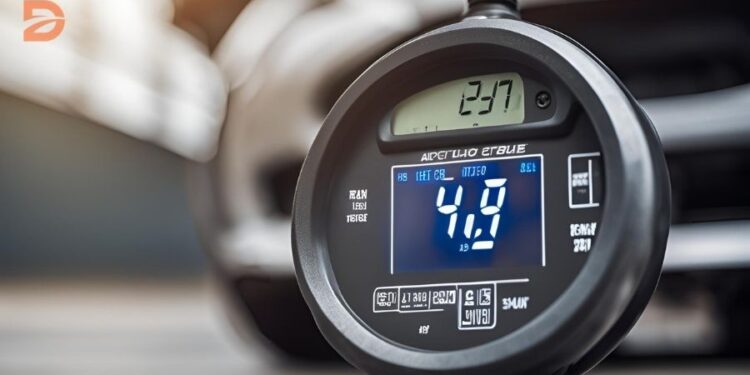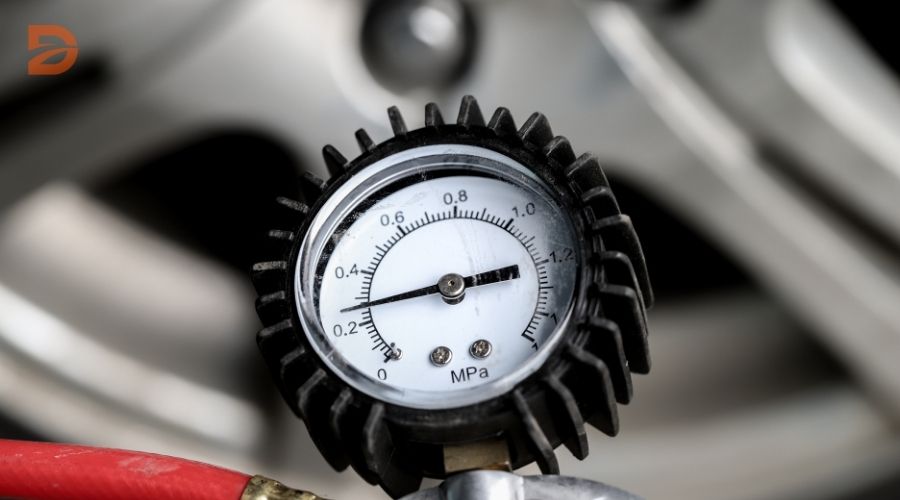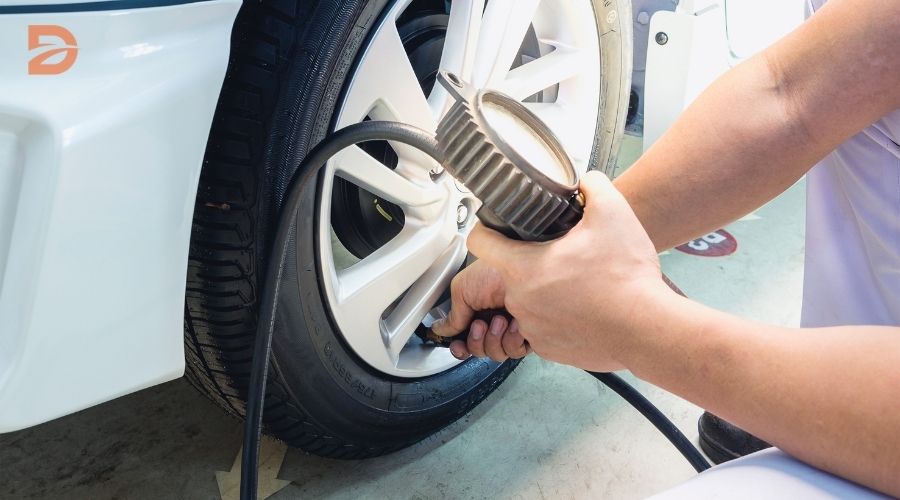In the ever-evolving world of automotive maintenance, one tool has risen to the forefront: the digital tire pressure gauge. But what sets these modern marvels apart from their analog counterparts, and why should you consider making the switch? Prepare to uncover the secrets behind the precision and convenience of digital tire gauges.
Digital tire pressure gauges have gained popularity in recent years due to their advanced technology and ease of use. They utilize electronic components to measure and display tire pressure in a digital format, providing clear and easy-to-read pressure readings. Digital gauges are known for their high level of accuracy and precision, often displaying pressure values up to the decimal point. This precision can be particularly beneficial for vehicles with specific tire pressure requirements.
However, the advantages of digital tire gauges extend far beyond their accuracy. Many models offer additional features such as programmable target pressure settings, automatic shut-off to conserve battery life, and the ability to switch between different pressure units, making them a versatile and user-friendly tool for any automotive enthusiast.
Key Takeaways
- Digital tire pressure gauges provide highly accurate pressure readings, often to the decimal point.
- They offer convenient features like programmable target pressure settings and automatic shut-off to conserve battery life.
- Digital gauges are well-suited for vehicles with specific tire pressure requirements, ensuring optimal performance and safety.
- The ease of use and clear digital display of digital tire gauges make them a popular choice among automotive enthusiasts.
- Despite their advantages, digital gauges may be more susceptible to extreme temperature fluctuations compared to analog models.
As you navigate the world of tire maintenance, the choice between digital and analog gauges may seem like a daunting one. But with a deeper understanding of the benefits and limitations of each, you’ll be well on your way to making an informed decision that keeps your vehicle’s tires at their optimal pressure – and your driving experience as smooth as the road ahead.
Understanding Digital Tire Pressure Gauges
Introduction to Digital Tire Pressure Gauges
Digital tire pressure gauges have become a popular choice among automotive enthusiasts and professionals due to their advanced features and superior accuracy. These modern tools utilize electronic components to measure and display tire pressure, providing a more precise and user-friendly alternative to traditional analog gauges.
Advantages and Disadvantages of Digital Gauges
The key advantages of digital tire pressure gauges include their high accuracy, with the ability to display pressure readings up to decimal points for enhanced precision. They also offer a variety of additional features, such as backlighting for improved visibility, programmable settings, and the integration of functions like tread depth measurement or a built-in flashlight. Additionally, digital gauges provide instant, easy-to-read digital displays, eliminating the need for manual interpretation of analog scales.
However, digital tire pressure gauges do have some potential drawbacks. They rely on batteries for operation, which can lead to concerns about battery life and the inconvenience of replacing them. Furthermore, digital gauges may be more sensitive to extreme temperatures, potentially affecting their performance and accuracy in certain environments.
| Digital Tire Pressure Gauges | Analog Tire Pressure Gauges |
|---|---|
|
|
|
|
When choosing between digital and analog tire pressure gauges, it’s important to consider your specific needs and preferences, balancing factors such as accuracy, ease of use, durability, and cost. Both types of gauges have their strengths and weaknesses, and the right choice will depend on your requirements and the demands of your automotive applications.
Digital tire pressure gauges, accuracy
When it comes to measuring tire pressure, digital tire pressure gauges offer unparalleled accuracy and precision. Unlike their analog counterparts, digital gauges can often provide readings to the decimal point, ensuring you get the most accurate PSI measurements for your vehicle. However, there are a few key factors to consider when using these high-tech automotive tools.
Factors to Consider When Using Digital Gauges
One important factor is battery life and replacement. Digital gauges rely on batteries to operate, so it’s crucial to monitor the battery status and replace them when necessary to maintain accurate readings. Additionally, extreme temperatures, whether hot or cold, can impact the performance and accuracy of digital gauges. It’s essential to use and store these tools within the manufacturer’s specified temperature range to ensure reliable measurements.
| Product | Price | Accuracy | PSI Range | Temperature Range |
|---|---|---|---|---|
| Accutire MS-4021 Digital | $18 | 9.0 | 5 to 150 PSI | 14 to 122°F |
| JACO ElitePro 100 PSI | $23 | 8.0 | 0 to 100 PSI | -10 to 122°F |
| Milton S-921 Pencil Gauge | $10 | 3.0 | 0 to 50 PSI | Suitable for cold weather |
| AstroAI Digital Dual Head 230 PSI | $21 | 5.0 | 0 to 230 PSI | 23 to 122°F |
| Digital Tire Pressure Gauge | $47.99 | 0.8% | 0-60 or 0-100 PSI | 0-130°F |
When selecting a digital tire pressure gauge, be sure to consider factors like accuracy, pressure range, and operating temperature to ensure you get the best tool for your needs. Investing in a high-quality digital gauge can make a significant difference in maintaining the optimal tire pressure for your vehicle, ultimately improving performance, fuel efficiency, and overall safety.
Exploring Analog Tire Pressure Gauges
Analog tire pressure gauges have been a trustworthy tool for measuring tire pressure for many years. These mechanical devices utilize a round dial with a needle indicator and a scale that displays the pressure in PSI (pounds per square inch) or other relevant units. When the gauge is pressed onto the tire valve stem, the pressure inside the tire compresses a spring within the gauge, causing the needle to move and indicate the pressure on the scale.
Pros of Analog Tire Pressure Gauges
- Relatively accurate readings, often measuring up to 100 PSI
- Durable construction with robust materials like metal or heavy-duty plastic
- Easy to read the large dial and clear scale, even in varying lighting conditions
- Typically have a lower initial cost compared to digital tire pressure gauges
- Don’t require batteries, making them a reliable option in all situations
- Known for their longevity and resistance to wear and tear
Cons of Analog Tire Pressure Gauges
- May not provide the same level of precision as digital gauges, typically accurate to within 1 PSI
- Require occasional calibration or zeroing to maintain accuracy, unlike digital gauges.
- Lack of advanced features found in digital gauges, such as programmable target pressure settings or automatic shut-off
- Analog gauges do not offer high-tech features like Bluetooth connectivity or integrated tread depth measurement seen in some digital models.
Overall, analog tire pressure gauges are a reliable and cost-effective solution for measuring tire pressure, especially for basic inflation tasks. While they may not offer the same level of precision and advanced features as their digital counterparts, analog gauges remain a popular choice among automotive enthusiasts and professionals due to their durability and ease of use.
Choosing the Right Gauge for Your Needs
When selecting a tire pressure gauge, it’s crucial to consider your personal preferences and specific requirements. Factors like the level of accuracy needed, whether you prefer a traditional analog gauge or a modern digital one, and if additional features such as backlighting or programmable settings are important can all play a role in your decision.
Assessing Your Preferences and Requirements
Start by evaluating your needs. Do you require highly precise pressure readings, or is a general range sufficient? Do you prefer the simplicity of an analog gauge or the advanced features of a digital one? Consider how you’ll be using the gauge, whether for regular vehicle maintenance or occasional checks before long trips.
Comparing the Pros and Cons of Analog and Digital Gauges
Both analog and digital tire pressure gauges have their advantages and disadvantages. Analog gauges are generally more durable, less dependent on batteries, and have a lower initial cost, but they may be less precise and have limited readability in low-light conditions. Digital gauges, on the other hand, offer higher accuracy and precision, as well as additional features like programmable settings and backlighting, but they are typically more expensive and reliant on battery power.
| Feature | Analog Gauges | Digital Gauges |
|---|---|---|
| Accuracy | Generally accurate within 1-2 PSI | Highly accurate, often displaying pressure to the decimal point |
| Ease of Use | Require interpretation of the pressure scale | Provide instant, easy-to-read digital displays |
| Durability | More robust and resistant to wear and tear | May be more fragile and susceptible to damage |
| Battery Dependence | Less reliant on batteries, with a longer lifespan | Require batteries for operation, with varying battery life |
| Cost | Generally more affordable | Typically more expensive |
Considering factors such as accuracy, ease of use, durability, and additional features can help you determine which type of tire pressure gauge best suits your vehicle maintenance needs.
Best Practices for Using Tire Pressure Gauges
Proper technique when using a tire pressure gauge is essential for obtaining accurate readings and maintaining optimal tire pressure. Whether you’re using a digital or analog gauge, following a few simple steps can ensure your vehicle’s tires are inflated to the manufacturer’s recommended levels, enhancing performance, fuel efficiency, and safety.
Importance of Proper Technique When Using Gauges
Ensuring your tire pressure gauge is calibrated and zeroed before each use is crucial. This step helps eliminate any inaccuracies in the readings, allowing you to make informed decisions about your vehicle’s tire inflation. Additionally, firmly pressing the gauge onto the tire’s valve stem prevents air leakage, which could skew the measurement.
Step-by-Step Guide for Accurate Tire Pressure Measurements
- Remove the valve cap from the tire’s valve stem.
- Press the tire pressure gauge firmly onto the valve stem, creating a tight seal to prevent air leakage.
- Wait for the reading to stabilize on the gauge’s display.
- Compare the measured pressure to the recommended tire pressure specified by the vehicle manufacturer.
- If the pressure is too low, add air until it reaches the correct level. If the pressure is too high, release air until the desired pressure is achieved.
- Repeat the process for each tire on your vehicle.
- Replace the valve caps securely once you have finished.
By following these steps, you can ensure accurate tire pressure measurements and maintain your vehicle’s optimal performance, tire inflation, and vehicle maintenance.
Conclusion
Digital tire pressure gauges offer a range of advanced features, high accuracy, and user-friendly operation, making them a popular choice for tire maintenance tasks. However, analog gauges still have their advantages, such as durability and simplicity. When selecting a tire pressure gauge, it’s crucial to consider your specific needs, preferences, and budget to choose the one that best suits your requirements.
Proper technique and following best practices when using any tire pressure gauge are essential for maintaining accurate readings and ensuring the safety and performance of your vehicle. Regular tire pressure checks, along with proper inflation levels, can help improve fuel efficiency, extend tire lifespan, and enhance overall vehicle safety.
Whether you opt for a digital or analog tire pressure gauge, the key is to prioritize accuracy, reliability, and ease of use to ensure your tires are properly inflated and your vehicle is operating at its best. By making informed choices and following the recommended guidelines, you can maximize the benefits of your tire pressure gauge and enjoy a safer, more efficient driving experience.
FAQ
What are the key features of digital tire pressure gauges?
Digital tire pressure gauges utilize electronic components to measure and display tire pressure in a digital format, providing clear and easy-to-read pressure readings. They are known for their high level of accuracy and precision, often displaying pressure values up to the decimal point.
What are the advantages of using digital tire pressure gauges?
Digital tire pressure gauges offer several advantages, such as high accuracy and precision, easy-to-read digital displays, and additional features like programmable settings and backlighting.
What are the potential drawbacks of digital tire pressure gauges?
Some potential drawbacks of digital tire pressure gauges include battery dependency, sensitivity to extreme temperatures, and typically higher initial cost compared to analog gauges.
How do analog tire pressure gauges work?
Analog tire pressure gauges utilize a mechanical system to provide pressure readings, consisting of a round dial with a needle indicator and a scale that displays the pressure in PSI (pounds per square inch) or other relevant units.
What are the advantages of analog tire pressure gauges?
Analog tire pressure gauges have several advantages, such as relatively accurate readings, durability, and ease of use. They are often constructed with robust materials like metal or heavy-duty plastic, making them resistant to wear and tear.
What factors should I consider when choosing a tire pressure gauge?
When selecting a tire pressure gauge, it’s essential to consider your personal preferences and specific requirements, such as the level of accuracy needed, whether you prefer a traditional analog gauge or a modern digital one, and if additional features like backlighting or programmable settings are important to you.
How can I ensure accurate tire pressure readings?
To measure tire pressure accurately, it’s important to follow proper technique, which involves ensuring the gauge is calibrated and zeroed before each use, placing the gauge firmly onto the valve stem to prevent air leakage, and waiting for the reading to stabilize.










